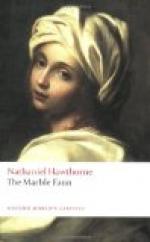Of course there could be no real doubt that it was Miriam, his artist friend, with whom and Hilda he had spent so many pleasant and familiar hours, and whom he had last seen at Perugia, bending with Donatello beneath the bronze pope’s benediction. It must be that selfsame Miriam; but the sensitive sculptor felt a difference of manner, which impressed him more than he conceived it possible to be affected by so external a thing. He remembered the gossip so prevalent in Rome on Miriam’s first appearance; how that she was no real artist, but the daughter of an illustrious or golden lineage, who was merely playing at necessity; mingling with human struggle for her pastime; stepping out of her native sphere only for an interlude, just as a princess might alight from her gilded equipage to go on foot through a rustic lane. And now, after a mask in which love and death had performed their several parts, she had resumed her proper character.
“Have you anything to tell me?” cried he impatiently; for nothing causes a more disagreeable vibration of the nerves than this perception of ambiguousness in familiar persons or affairs. “Speak; for my spirits and patience have been much tried to-day.”
Miriam put her finger on her lips, and seemed desirous that Kenyon should know of the presence of a third person. He now saw, indeed, that, there was some one beside her in the carriage, hitherto concealed by her attitude; a man, it appeared, with a sallow Italian face, which the sculptor distinguished but imperfectly, and did not recognize.
“I can tell you nothing,” she replied; and leaning towards him, she whispered,—appearing then more like the Miriam whom he knew than in what had before passed,—“Only, when the lamp goes out do not despair.”
The carriage drove on, leaving Kenyon to muse over this unsatisfactory interview, which seemed to have served no better purpose than to fill his mind with more ominous forebodings than before. Why were Donatello and Miriam in Rome, where both, in all likelihood, might have much to dread? And why had one and the other addressed him with a question that seemed prompted by a knowledge of some calamity, either already fallen on his unconscious head, or impending closely over him?
“I am sluggish,” muttered Kenyon, to himself; “a weak, nerveless fool, devoid of energy and promptitude; or neither Donatello nor Miriam could have escaped me thus! They are aware of some misfortune that concerns me deeply. How soon am I to know it too?”
There seemed but a single calamity possible to happen within so narrow a sphere as that with which the sculptor was connected; and even to that one mode of evil he could assign no definite shape, but only felt that it must have some reference to Hilda.




